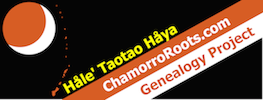
From what we know today, the recording of names of the ancient Chamorro people, who referred to themselves as Taotao Håya, continues to remain very sparce. Beginning with European contact in 1521 and until 1602, it is very difficult to find any indigenous names within the literature available.
However, by 1602 one of the objectives of a group of Spanish ships was to stop by the Mariana Islands to retrieve shipwrecked survivors of the Santa Margarita. On board one of the visiting ships was Fray Juan Pobre who deserted his ship by jumping into a “canoe” of an unnamed native while the Spanish ships sailed away without him and another Friar.
Although Pobre’s excursion in the Mariana Islands was only for about seven months (March – October 1602), he made efforts to learn about the Taotao Håya and wrote about his encounters that were eventually transcribed. His 1602 recordings seems to be among the earliest, if not the first, to name an indigenous family with whom he had stayed with while in Luta (Rota, at the time was also called and recorded as Carpana [Zarpana] by the Spaniards).
This Taotao Håya manggåfa (family) consisted of Sunama, his wife Sosanbra, their “eldest son” Maripego, and two daughters: Marifoquez and Mominasaria. Unfortunately, the transcribed recordings of Pobre do not seem to indicate the name(s) and mention of how many other sons Sunama and Sosanbra may have had. This family resided in the village Tazga, Rota.
Reference:
Marjorie G. Driver. 1988. Fray Juan Pobre de Zamora: Hitherto unpublished accounts of his residence in the Mariana Islands, The Journal of Pacific History, 23:1, 86-94, DOI: 10.1080/00223348808572578.

